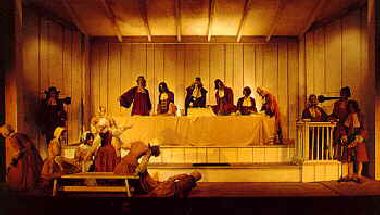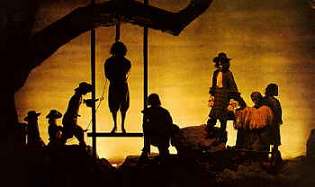Several residents of Salem, Mass., testified Tuesday that Rebecca Nurse, long known as one of the most pious women in the community, had haunted them in visions.

"The apparition of Rebecca Nurse did fall upon me and almost choked me," said Ann Putnam. "She told me now that she had come out of prison and she had the power to afflict me," Putnam said.
Nurse, 71, was charged with witchcraft in March of 1692 after 11-year old Abigail Williams accused her. Williams and several other girls allege that "witches" within the community have been making them fall into fits, writhe on the floor and clench their fists.
Several other women and a child have also been charged with witchcraft including Sarah Good, Martha Cory, Sarah Osborne, and four-year old Dorcas Good.
Bridget Bishop was the first person executed for witchcraft. She was hung June 10.
Nurse is known throughout the community for constantly quoting the Bible and never missing a day in church. The mother of four sons and four daughters, she seems an unlikely person to be accused of witchcraft.
The charge against her surprised friends. "She has brought up a great family of children and educated them well so that there is in some of them an appearance of godliness," said Nathaniel Putnam, Sr.
Thirty-nine people have signed a petition declaring Nurse innocent.
"I have known her to differ with her neighbors, but I have never heard them accuse her of this," Nathaniel Putnam said.
Sarah Holton, one of Nurse's neighbors, disagreed with Putnam. Holton said Nurse had scolded Holton and her husband because their pigs were loose on Nurse's property.
"All we could say to her could in no way pacify her, but she continued railing and scoldng while calling to her son to go get a gun and kill our pigs," Holton said.
Shortly after the disagreement, Holton's husband, Benjamin, began to exhibit strange symptoms, she said.
"He was taken with a strange fit in the entry way of our house, struck blind and struck down two or three times," Sarah Holton said.
"He continued in a languishing condition, and about a fortnight before he died, he was taken with strange and violent fits acting much like our poor bewitched persons," Holton said.
Ann Putnam, following Holton's testimony said she had a terrifying vision about Nurse. "Six children appeared before me in winding sheets and called me aunt and told me that Nurse was one of the people who murdered them," Putnam said.
Nurse, who appeared frail, and coughed constantly, defended herself against the charges. "In this, I am as innocent as an unborn child," she said. The defendants are not allowed to have lawyers.
At one point when Nurse raised her hands in astonishment at the charges, several of the girls in the courtroom started writhing on the floor and silently gasping.
The girls couldn't speak for ten minutes but finally stood up one by one and pointed at Nurse who was holding her head in her hands.
Judge John Harthorne abruptly told the girls to sit down and asked Nurse if she was a witch.
"How far have you complied with Satan?" Harthorn said. He had to repeat his question because Nurse has lost some of her hearing.
She again said she was innocent. "I never complied but prayed against him," Nurse said.

The following is from the Salem Witch Museum
In January of 1692, the daughter and niece of Reverend
Samuel Parris of Salem Village became ill. When they failed
to improve, the village doctor, William Griggs, was called in.
His diagnosis of bewitchment put into motion the forces
that would ultimately result in the death by hanging of
nineteen men and women. In addition, one man was
crushed to death; seventeen others died in prison, and the
lives of many were irrevocably changed.
To understand the events of the Salem witch trials, it is
necessary to examine the times in which accusations of
witchcraft occurred. There were the ordinary stresses of
17th-century life in Massachusetts Bay Colony. A strong
belief in the devil, factions among Salem Village fanatics
and rivalry with nearby Salem Town, a recent small pox
epidemic and the threat of attack by warring tribes created
a fertile ground for fear and suspicion. Soon prisons were
filled with more than 150 men and women from towns
surrounding Salem. Their names had been "cried out" by
tormented young girls as the cause of their pain. All would
await trial for a crime punishable by death in 17th-century
New England, the practice of witchcraft.
In June of 1692, the special Court of Oyer (to hear) and
Terminer (to decide) sat in Salem to hear the cases of
witchcraft. Presided over by Chief Justice William Stoughton,
the court was made up of magistrates and jurors. The first to
be tried was Bridget Bishop of Salem who was found guilty
and was hanged on June 10. Thirteen women and five men
from all stations of life followed her to the gallows on three
successive hanging days before the court was disbanded by
Governor William Phipps in October of that year. The Superior
Court of Judicature, formed to replace the "witchcraft"
court, did not allow spectral evidence. This belief in the
power of the accused to use their invisible shapes or spectres
to torture their victims had sealed the fates of those tried by
the Court of Oyer and Terminer. The new court released
those awaiting trial and pardoned those awaiting execution.
In effect, the Salem witch trials were over.
As years passed, apologies were offered, and restitution was
made to the victims' families. Historians and sociologists have
examined this most complex episode in our history so that
we may understand the issues of that time and apply our
understanding to our own society. The parallels between the
Salem witch trials and more modern examples of "witch
hunting" like the McCarthy hearings of the 1950's, are
remarkable.
Rebecca Nurse was hung. None of the bodies could be buried in "consecrated ground, the whereabouts of any of the burial sites are long lost.

